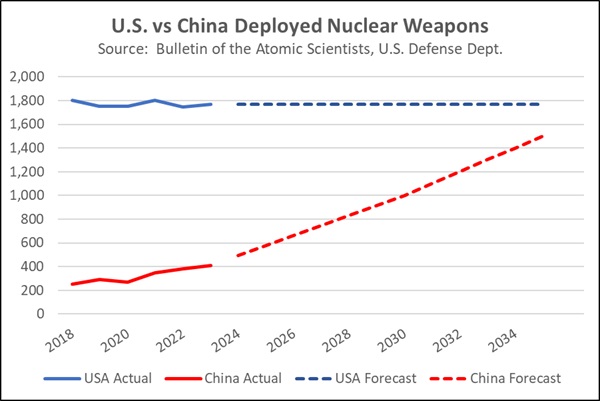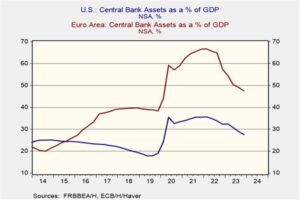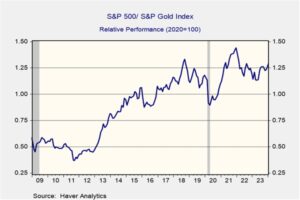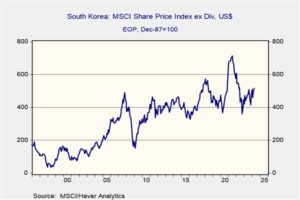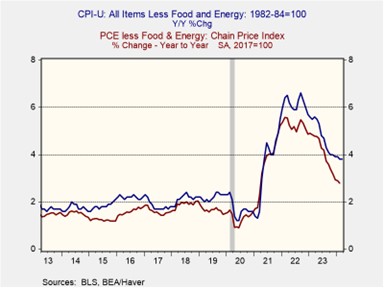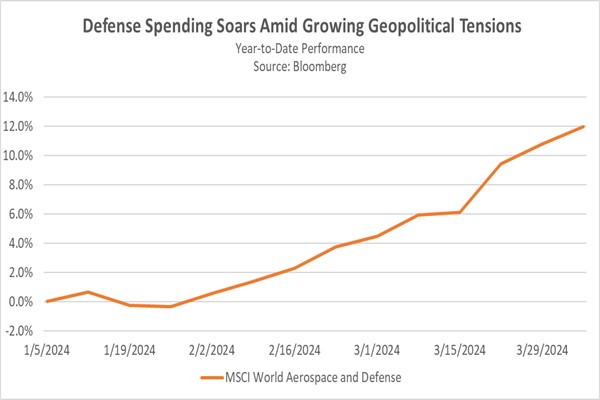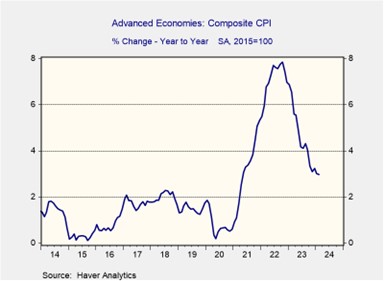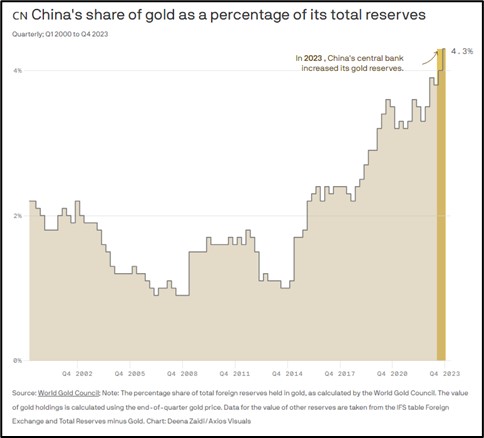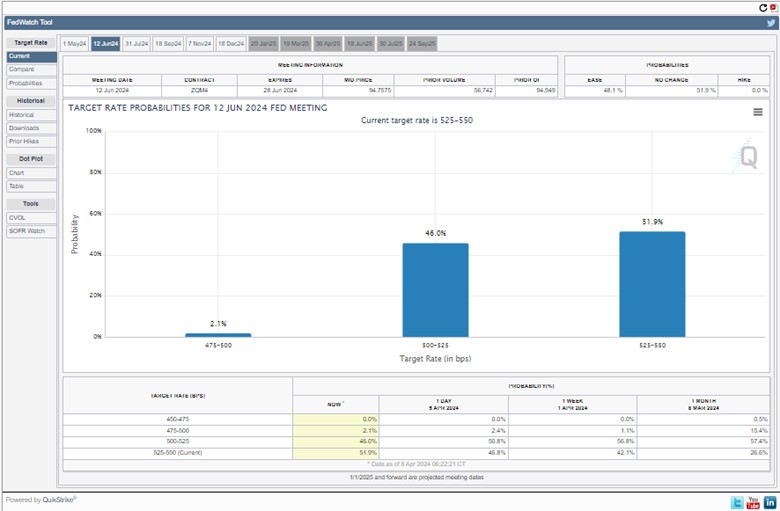Author: Amanda Ahne
Asset Allocation Bi-Weekly – The Incremental Uranium Demand for Weapons (April 15, 2024)
by the Asset Allocation Committee | PDF
In our Asset Allocation Bi-Weekly report from March 4, 2024, we began to explain more fully our recent decision to introduce uranium and uranium miners into our Asset Allocation strategies. Our key thesis was that current and planned investments in new nuclear reactors for electricity generation, especially in China and India, will likely lead to booming demand for uranium in the coming decades, while supplies are likely to be constrained. This theory is increasingly discussed among investors, and we think it’s a key reason for the jump in spot uranium prices since 2022, as shown in the chart below. In this report, we discuss a less-recognized source of incremental uranium demand that could drive prices even higher: China’s ongoing rapid expansion in its arsenal of nuclear weapons and the possibility of a global nuclear arms race in the future.
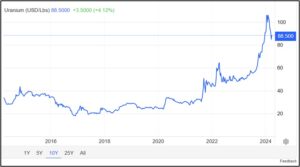
After decades of keeping only a “minimal” nuclear deterrent of about 200 warheads, China has recently begun a dramatic expansion of its arsenal. Western analysts believe China’s arsenal has expanded by about 42 warheads annually since 2020, reaching 500 warheads in 2024. Publicly observable and classified evidence suggests Beijing aims to match the United States’s deployed arsenal of 1,770 warheads by 2035 (not including reserves), which would imply adding an average of 115 warheads per year until then. Finally, as we have written elsewhere, we think rising geopolitical tensions around the globe and growing doubts about the US’s commitment to its allies could potentially prompt a dozen or more non-nuclear states to develop nuclear weapons in the coming decade or two. If that results in a global nuclear arms race, the world could end up producing several hundred new nuclear warheads each year.
In every scenario we’ve looked at, China would be the main driver of new nuclear weapons production in the years to come. So, in order to understand the incremental uranium demand for weapons, we will focus on China’s expected needs. Because of China’s long nuclear history and technological prowess, we assume its nukes are similar to the advanced, plutonium-based hydrogen bombs fielded by the US and Russia. According to a 1999 declassification guide from the Department of Energy, such bombs can theoretically be made with just 6 kg of plutonium, similar to the mass of fissile material for a uranium-based bomb. Another DOE report says that the US has used 3.4 metric tons of plutonium in its 1,054 nuclear tests since World War II, implying the use of about 3.25 kg per test. Actual weapons probably use more plutonium than the hypothetical minimum or test levels, so we assume current and future Chinese bombs would use at least 10 kg of plutonium each. Data on weapons-grade uranium and plutonium stocks from the International Panel on Fissile Materials suggests modern hydrogen bombs encompass an average of about 15 kg of plutonium each, which we use in our calculations below.
Of course, very little plutonium occurs naturally on Earth; it is generally made from uranium. Open-source reports indicate that producing 1 kg of plutonium takes about 4,000 kg of uranium. If these reports are accurate, each new Chinese warhead requires about 60 tons of uranium, and China’s current annual production of about 42 warheads probably represents about 2,520 tons of uranium. Unclassified sources don’t clarify what form of uranium is used in the 1:4,000 ratio, but if it is standard uranium mine output (i.e., “yellowcake,” or minimally processed ore consisting of about 85% triuranium octoxide), then China’s current annual nuclear weapons output is using the equivalent of 4.2% of the approximately 60,000 tons of uranium that was produced by mines around the world in 2023. We therefore suspect that China’s current nuclear build-up is probably helping to buoy spot uranium prices even today.
Looking forward, if China increases its bomb output to the expected 115 per year, its nuclear program would require at least 11.5% of 2023’s global mine output and would more obviously put upward pressure on uranium prices. Moreover, we believe our estimates could be quite conservative. For example, it may be that the plutonium/uranium ratio of 1:4,000 refers to pure or enriched uranium, which would imply that even greater quantities of uranium ore are needed. China might also decide to build up an inventory of reserve warheads, further boosting the need for uranium ore. Plutonium and uranium production waste may also boost uranium needs. Finally, if geopolitical tensions do result in a global nuclear arms race, we believe the total uranium demand from China, Russia, the US, all other existing nuclear states, and new nuclear states could easily overwhelm global supplies and send long-term uranium spot prices dramatically higher.
Daily Comment (April 12, 2024)
by Patrick Fearon-Hernandez, CFA, and Thomas Wash
[Posted: 9:30 AM EDT] | PDF
Good morning! Equities are off to a slow start today as investors await key bank earnings reports. In a separate development, NFL fans are buzzing after quarterback Tom Brady hinted at a possible return. Today’s Comment examines the contrasting monetary policies of the ECB and the Fed, explores the reasons behind gold’s recent surge in investor interest, and analyzes the potential impact of South Korea’s parliamentary elections on its stock market. As always, we conclude with a summary of key domestic and international data releases.
Taking Different Paths: The ECB and the Federal Reserve are diverging on monetary policy, with both looking to loosen restrictions without abandoning their goals.
- The FOMC minutes unveiled on Wednesday provide valuable insights into the Federal Reserve’s strategy for balance sheet reduction. FOMC policymakers have signaled an openness to initiating this process, with a primary focus on scaling back the pace of US Treasury roll-off while maintaining mortgage-backed securities unchanged. While a specific start date isn’t confirmed, May or June are possible targets. Chair Powell stressed a gradual approach to control the process. This aims to reduce reserves from “abundant” to an as yet to be defined “ample” level, with the hopes of preventing disruptions similar to the 2019 short-term funding market issues.
- The European Central Bank (ECB) is taking a contrasting approach. The ECB is maintaining its current pace of balance sheet reduction, continuing to unwind its asset purchase program, and stopping the reinvestment of bonds from its pandemic program by year-end. This last step will significantly accelerate the shrinking of the ECB’s balance sheet. This faster drawdown aims to both limit new money entering the financial system and counteract any stimulus from potential future rate cuts, aligning with the ECB’s mission of ensuring the return of price stability within the market.
- The central banks are taking different approaches to monetary policy based on their economic concerns. The Fed’s measured pace of balance sheet reduction suggests a focus on preventing financial instability, possibly due to rising liquidity concerns. In contrast, the ECB’s preference for rate cuts suggests policymakers are worried about rising defaults, hoping lower rates will allow businesses to refinance debt more easily. That said, these adjustments by central banks may not signal a return to loose monetary policy, but rather a moderation of previous tightening measures. Investors should therefore remain cautious about excessive risk-taking.
Gold Bugs in Charge: The bullion has surged in recent months as central banks have looked to acquire the metal as a hedge against the dollar.
- Several factors are driving the gold surge, including heightened demand from central banks in emerging economies, such as China, that are seeking alternatives to the dollar. Investors are also increasingly drawn to safe havens due to rising geopolitical risks and uncertainty surrounding Fed policy rates, which could erode the value of US Treasurys. Additionally, consumers are actively seeking alternative assets to safeguard their savings amid sustained inflationary pressures. As a result, gold has been a star performer in 2024, outperforming the S&P 500 with a year-to-date return of 16.0% compared to 9.6%.
- Traditionally, gold and stocks have moved in opposite directions during uncertain times. But over the past five years, a surprising trend has emerged of a strong positive correlation, with both assets rising in tandem. The five-year moving correlation has jumped to +0.84, significantly above its historical norm of +0.22. This breakdown of the usual inverse relationship suggests a more complex market environment. While economic optimism typically fuels stock prices, with investors betting on growing companies, rising gold prices might indicate underlying anxieties about the high valuation of tech companies.
- A key factor influencing gold’s price momentum hinges on the Federal Reserve’s ability to achieve a soft landing – controlling inflation without stalling economic growth. Recent comments from Boston Fed President Susan Collins and Fed Governor John Williams suggest policymakers are cautious about cutting rates given the current elevated inflation levels. If policymakers continue to hold rates higher than the market is expecting, it may encourage more investors to purchase gold in order to hedge against a possible hard landing or an unexpected acceleration in inflation.
Yoon in Trouble: South Korea’s parliamentary election results dealt a severe blow to the ruling Conservative party, raising doubts about its ability to hold the government together.
- In Wednesday’s parliamentary elections, the liberal opposition in South Korea achieved a resounding victory, securing 175 out of 300 seats in parliament. Although the opposition fell short of the 200 seats required for a supermajority, its win holds significant implications. This strong opposition suggests that President Yoon Suk Yeol will need help enacting his agenda. He may be forced to compromise with the opposing side, which could significantly weaken his proposals. Following the crushing defeat, the prime minister and other senior officials tendered their resignations, which paves the way for the president to reshuffle his cabinet in response to the election results.
- The election outcome raises questions about the planned reforms designed to enhance the appeal of South Korean equities. President Yoon had pledged to eliminate the planned capital gains taxes on financial investment income before the election. He also proposed a program to address the issue of Korean companies trading at lower valuations relative to their global peers, a phenomenon known as the Korea discount. Despite some hope that the reforms would survive in a weakened form, the uncertainty surrounding their implementation is likely weighing on investors and contributing to today’s decline in the KOSPI.
- South Korea’s recent political situation exemplifies the challenges in making its equities more attractive. However, the country’s booming semiconductor industry, especially with its strengthened ties to the US, Japan, and Taiwan for chip security, offers a potential bright spot for investors seeking exposure beyond a weakening China. Investor confidence hinges on lawmakers’ ability to encourage companies to prioritize shareholder value alongside other considerations during decision-making. Unfortunately, the recent parliamentary shift makes achieving this reform more difficult, potentially dampening hopes for a rally similar to the one experienced by the Japanese stock market in recent years.
In Other News: Iran has signaled a limited response to Israel, easing fears of wider conflict in the Middle East. China’s exports fell more than expected in March, raising concerns about its economic slowdown. Meanwhile, former Fed Chair Bernanke unveiled revamped economic models for the BOE in a sign that central bankers are adapting to a changing world.
Daily Comment (April 11, 2024)
by Patrick Fearon-Hernandez, CFA, and Thomas Wash
[Posted: 9:30 AM EDT] | PDF
Good morning! Equities are mixed after the weaker-than-expected PPI report. In a Champions League upset, Barcelona edged past PSG in Paris, and took a 1-goal lead into the return leg. Today’s Comment examines how rising inflation (CPI) impacts interest rates, explores the increase in defense spending due to growing geopolitical tensions, and analyzes the hints of possible easing by the ECB as part of a wider trend among developed central banks.
Rate Cut Expectations: Stronger-than-expected March inflation and hawkish FOMC meetings have led to a rethink on rate cuts.
- Inflation surged in March, exceeding forecasts, and year-over-year consumer prices jumped to 3.5% (up from 3.2% in February). Core CPI, excluding volatile food and energy, also climbed to 3.8%, driven by rising costs in housing, healthcare, and car insurance. This robust report dampens hopes for the Fed achieving its 2% target, as indicated in recent meeting minutes. The minutes also reveal a divided committee, where some members fear geopolitical tensions and relaxed financial conditions could further inflate prices. In contrast, others see the potential for downward pressure from technological advancements and continued immigration.
- Recent data exposes unexpected inflation trends. Despite the Federal Reserve’s anticipation of falling housing costs, shelter inflation remains stubbornly high. The three-month annualized rate rose to a worrying 7.11% in March, a significant departure from the expected disinflation. Furthermore, inflation isn’t limited to housing. Core services, excluding rent, have also seen substantial increases, rising 9.3% at an annualized rate over the past three months. This unexpected increase in core services, which are sensitive to wages, suggests a tight labor market, which could fuel broader inflationary pressures.
- March CPI data complicates the Fed’s policy decisions. Their preferred gauge, core PCE inflation, is near their target (2.78% vs 2.50% target range). However, headline CPI inflation, the more widely followed measure, remains above 3.5%. This divergence creates a challenge. The higher CPI number suggests the Fed may now need to hold interest rates steady for a longer period than initially anticipated to avoid accusations of partisanship in an election year. Although a summer rate cut isn’t entirely off the table, its likelihood has diminished significantly.
Defense Spending Splurge: Rising global tensions are prompting governments to ramp up defense spending in a bid to deter potential adversaries.
- The Middle East simmers with escalating tensions as the US and Israel ramp up collaboration on missile defense. This follows recent threats from Iran vowing retaliation after a strike in Syria killed a high-ranking Iranian general. The simmering conflict raises fears of a wider regional war, with US officials warning of potential targeted missile attacks by Iran. In a defiant move, Israel issued a stark warning, promising a forceful response on Iranian soil if its borders are breached. Adding to the regional turmoil, two major disputes threaten to ignite further chaos: Ukraine and Russia, as well as Armenia and Azerbaijan.
- While a wider Middle Eastern conflict remains a major concern, the drone revolution is another threat to global stability that shouldn’t be underestimated. Iran’s cheap, combat-proven drones are captivating developing nations, bolstering defenses and aiding militaries like those in Ukraine and Sudan. Their global production network, spanning South America and Central Asia (including some US parts), raises questions about the effectiveness of sanctions. Meanwhile, Ukraine’s experience exposes limitations in US drone capabilities, prompting Ukraine to explore Chinese alternatives for reconnaissance. This highlights how any nation, regardless of size, can exploit niche strengths, reshaping the modern military landscape.
- The intensifying tensions in both the Middle East and Asia emphasize the critical importance of resilient supply chains. Recognizing the emerging alliance between Russia, China, and Iran, US allies are joining forces to bolster their military capacities, aiming to deter potential aggression. This collaborative effort is yielding early successes, as shown in the groundbreaking military drone radar developed by a notable French defense company. As geopolitical rifts deepen, the imperative for security investment grows, underscoring the importance for countries to support global defense companies in safeguarding collective defense interests.
ECB’s Cautious Pivot: The European Central Bank decided to hold rates steady as it prioritizes economic growth over the inflation fight.
- The ECB Governing Council voted to hold interest rates steady for the fifth consecutive meeting. The main refinancing rate remains at 4.5%, and the deposit rate stays at 4.0%. While the central bank’s updated policy statement hinted at a future easing of monetary restrictions, it provided no concrete timeline. However, there are strong indications that a rate cut could come as early as June. The ECB also plans to continue its balance sheet reduction program and will reinvest principal payments from its pandemic bond purchases until the end of 2024.
- In a sign of shifting tides, the ECB’s decision to hold rates steady reflects a growing global trend towards a pause in interest rate hikes. This follows the Swiss National Bank’s surprise rate cut last month, the first among G-7 central banks. Similarly, the Bank of Canada has hinted at a possible June cut as it looks to ease its rate by 100 bps by the end of the year. This cautious approach comes as inflationary pressures, which peaked in the summer 2022, have begun to show signs of moderation, and economic growth has become more of a concern.
- Global monetary policy is in uncharted territory as central banks are deviating from the Federal Reserve’s cautious approach. This divergence, coupled with ongoing doubts about the need for US rate cuts given its economic resilience and robust labor markets, could significantly strengthen the dollar. A stronger greenback could pose a double challenge for economies reliant on dollar-priced imports as it would exacerbate inflationary pressures, forcing them to reconsider planned rate cuts. Additionally, a robust US economy might lead their central banks to maintain higher interest rates than desired, potentially hindering domestic growth.
Other News: Manhattan rent dips hint at a stabilizing market, but high housing costs remain a hurdle for the central bank in achieving its 2% inflation target. Facing a persistent Russian offensive, Ukraine confronts growing challenges in maintaining momentum. Switzerland will hold a peace conference to mediate the Ukrainian/Russian crisis.
Daily Comment (April 10, 2024)
by Patrick Fearon-Hernandez, CFA, and Thomas Wash
[Posted: 9:30 AM EDT] | PDF
Our Comment today opens with a major new speech by a top European Union policymaker that calls for greater US-EU coordination to counter China’s unfair trade practices — a call that is likely to anger Beijing and fuel greater tensions between the West and China. We next review a wide range of other international and US developments with the potential to affect the financial markets today, including a new downgrade to the outlook for China’s credit rating and an Arizona Supreme Court ruling that could have an important impact on the US elections in November.
United States-European Union-China: In a major speech yesterday, European Commission market competition chief Margrethe Vestager called for the US and the EU to team up and present a more systematic, coordinated approach against China’s unfair trade practices. To protect their key industries of the future, Vestager outlined a strategy in which the US and EU, working together, could convince the Group of 7 countries to erect trade barriers against subsidized Chinese products being sold in the West at artificially low prices.
- Vestager also announced that the EU is launching an anti-dumping probe into Chinese wind turbines, just as it previously announced an investigation into the likely dumping of low-cost Chinese electric vehicles on the EU market.
- According to Vestager, “We saw the playbook for how China came to dominate the solar panel industry . . . We see this playbook now deployed across all clean tech areas, legacy semiconductors, and beyond, as China doubles down on a supply side support strategy to address its economic downturn.”
- The new anti-dumping probe is certain to generate complaints, pushback, and perhaps even retaliation by Beijing. Indeed, some European officials are likely to push back against the probe out of fear that China will retaliate by imposing new restrictions on their trade or investment flows. In the past, those concerns have limited the EU’s actions against China. However, faced with yet another onslaught of subsidized Chinese goods, the EU may ultimately impose tougher restrictions this time, as Vestager calls for.
- In any case, Vestager’s tough speech is a sign that economic tensions between the West and China aren’t going away anytime soon. They actually look set to worsen, since the Chinese government is likely to retaliate in one way or the other and shows no sign of wanting to shift away from its investment/export economic development strategy toward a consumption-led model.
Japan-China: In a new survey by Japanese news firm Yomiuri Shimbun, 92% of respondents said China is a threat to Japan’s national security, versus 86% who said the same in 2023 and 81% who said so in 2022. The responses help explain Tokyo’s enthusiastic support for the US effort to strengthen allied defense efforts against China’s increased geopolitical aggressiveness in the Indo-Pacific region. The results also suggest tensions between China and the westernized liberal democracies will continue to increase going forward.
China: Reflecting China’s slowing economic growth, slumping property market, and rising fiscal deficit, Fitch today maintained its A+ rating on the country’s sovereign debt but cut its outlook from stable to negative. The move follows a similar one by Moody’s in December, in which that company maintained its A1 rating on China’s long-term debt but also cut its outlook from stable to negative.
- China’s burgeoning public sector debt stems mostly from fiscal shortfalls at the provincial and local government levels. The central government has begun to issue its own new debt to rescue some of those lower-level governments, but that is putting new fiscal pressures on Beijing.
- The rising debt challenges compound other structural economic challenges that have come to light in recent years, such as excess industrial capacity, weak consumer demand, poor demographics, decoupling by foreign countries, and the disincentives from the Communist Party’s increasing intrusions into the economy.
- Not only are China’s debt and other structural economic problems creating headwinds for the country’s own economy and financial markets, but they are also holding down growth in some other countries.
Australia: The government said today that it will toughen the country’s corporate merger rules amid concerns that increased market concentration is stifling competition and boosting prices. Under the plan, the government will give the Australian Competition and Consumer Commission added powers to scrutinize mergers above certain value and market-share thresholds. The ACCC would also be given authority to stop small serial acquisitions that could reduce competition over time, bringing Australia’s rules in line with those of most other developed countries.
Eurozone: Big US money managers are reportedly shifting their bond purchases from US Treasuries to eurozone obligations in hopes that the European Central Bank could begin to cut its benchmark interest rate sooner and faster than the Federal Reserve will cut US rates. The improved outlook for eurozone bonds reflects Europe’s much weaker economy and rapidly falling inflation. In contrast, strong economic growth in the US is keeping price pressures high and threatening to delay the Fed’s interest-rate cuts.
US Politics: Responding to the US Supreme Court decision in June 2022 that rolled back federal protections for abortion, the Arizona Supreme Court yesterday ruled that a nearly total ban still on the books from Arizona’s territorial days must be reinstated. The move follows a recent Florida Supreme Court ruling that also allowed tighter restrictions, even as it approved a referendum on abortion rights in the November election.
- Although the rulings will have no discernible impact on the US economy or financial markets, they have the potential to affect the upcoming elections.
- Given that Democrats have shown they can exploit the June 2022 ruling that overturned Roe v. Wade, the rulings could help the party in Arizona, Florida, and even in other key swing states, despite current polling showing greater support for former President Trump than for President Biden.
US Postal System: The US Postal Service has requested permission to boost the price of a first-class stamp by an additional 5 cents. If approved in the coming weeks by the Postal Regulatory Commission, the cost of a stamp would rise on July 14 to $0.73, up 10.6% from one year earlier.
Daily Comment (April 9, 2024)
by Patrick Fearon-Hernandez, CFA, and Thomas Wash
[Posted: 9:30 AM EDT] | PDF
Our Comment today opens with some observations on gold prices, which hit a record high yesterday. We next review a wide range of other international and US developments with the potential to affect the financial markets today, including more signs of a Western trade war against China over its dumping of excess production on world markets and another indication that US commercial real estate prospects may be on the verge of improving.
Global Gold Market: Gold prices hit a new all-time record yesterday, closing at $2,357.80 per ounce despite investors’ realization that the Federal Reserve isn’t likely to cut interest rates as aggressively as previously thought (gold prices have historically been hurt by high real interest rates). In our view, the anomaly reflects a broad commodity rally, geopolitical tensions, and especially strong buying by central banks.
- Gold has long been seen as a “safe haven” asset that can hold its value in the face of currency debasement, rising price inflation, and wars or other geopolitical tensions.
- More recently, it’s become clear that gold is a safe haven even to foreign governments and their central bankers, especially in the rival China-led geopolitical bloc. As those governments and central banks digest how the West has essentially frozen or seized reserves held by countries like Afghanistan, Iran, and Russia, they’ve become much more intent on holding their reserves in hard assets such as the yellow metal.
- The process of central banks shifting their reserve holdings toward gold, silver, or other physical commodities could well continue for some time. Therefore, it’s possible that gold’s current uptrend will continue.
European Union-China: New reports say waves of imported autos are piling up at European ports, reflecting not just the onslaught of mostly Chinese-made vehicles but also a shortage of truckers to move them out and a slowdown in demand among European consumers. We think the situation will only make it more likely that the EU will formally impose anti-dumping tariffs or other trade barriers against China once its current investigation of the issue is completed.
European Union-Russia: Yesterday, the European Commission’s top diplomat, Josep Borrell became the latest high-level European official to warn of an impending war with Russia. In a speech in Brussels, Borrell warned that “Russia threatens Europe . . . War is certainly looming around us, and a high-intensity, conventional war in Europe is no longer a fantasy.” Consistent with our outlook for bigger military budgets around the world, Borrell urged the creation of a joint EU financing mechanism to boost the bloc’s defense industrial capacity to prepare for war.
Eurozone: The European Central Bank said its first-quarter survey of commercial banks revealed a substantial decline in corporate loan demand. The fall in demand for credit apparently reflects weaker investment plans, so the data may more strongly prompt the central bank to signal the beginning of interest-rate cuts when it holds its policy meeting later this week. At this point, investors largely expect the ECB to start cutting rates in June.
Turkey-Israel: Under domestic political pressure to do more to stop Tel Aviv’s war against Hamas in Gaza, the Turkish government today said it will restrict the export of 54 different products to Israel. The restrictions will affect exports ranging from construction machinery and metal products to fuels and oils. The move reflects how Israel’s war on Hamas and the resulting civilian casualties are increasingly isolating the country politically and economically, with potentially long-term consequences.
Japan: In testimony before parliament today, Bank of Japan Governor Ueda said the central bank will keep monetary policy accommodative for now, despite its decision to end its negative interest-rate policy last month. Ueda did say that the policymakers might reduce the amount of accommodation if consumer price pressures worsen, but he offered no firm guidance on when interest rates might rise again. The testimony suggests Japanese rates will rise only slowly and remain relatively low for the time being, keeping downward pressure on the yen.
United States-China: In her visit to China this week, Treasury Secretary Yellen has delivered a tough warning that the US will respond if Beijing keeps pushing unwarranted investment that leads to more excess capacity and increased dumping of cheap Chinese goods on the world market. However, Chinese officials have pushed back on the criticism, claiming that excess capacity is normal, and that China is merely trying to develop its economy appropriately.
- Yellen’s tough message and Beijing’s pushback point to further US-China tensions.
- As we have noted many times before, the increasing tensions threaten to catch investors in the crossfire going forward.
US Bond Market: Treasury yields across the maturity spectrum rose to their highest levels since November, with the benchmark 10-year rate closing yesterday at 4.422%. So far this morning, the higher yields appear to be enticing some investors to buy bonds again, pulling yields a bit lower. Nevertheless, as we noted in our Comment yesterday, investors are likely to remain skittish about buying fixed income in the face of sticky consumer price inflation and a Federal Reserve that is less likely to cut interest rates than earlier thought.
US Commercial Real Estate Market: Private investing giant Blackstone yesterday said it is buying Apartment Income REIT, known as AIR Communities, which owns 76 upscale apartment communities mostly in coastal markets such as Miami and Boston. The $10-billion buy comes after a period in which Blackstone was being cautious in the face of high interest rates, rising commercial real estate vacancies, and falling building values. The deal, therefore, could signal an upturn in the sector’s fortunes and a potential rebound in commercial real estate values.
Bi-Weekly Geopolitical Podcast – #45 “Is Japan Back?” (Posted 4/8/24)
Bi-Weekly Geopolitical Report – Is Japan Back? (April 8, 2024)
by Thomas Wash | PDF
In the early 1960s, futurologist Herman Kahn boldly predicted Japan’s economic dominance. He envisioned the nation surpassing the United States in per-capita economic output by 1990 and matching its total economic output a decade later. Kahn’s vision seemed imminent, fueled by Japan’s rise as a major exporter of autos and semiconductors. Japan’s advantages stemmed from its relatively cheap labor force, weak currency, and lower borrowing costs, which gave Japanese companies a significant edge over their American counterparts.
Just as Japan appeared poised to realize Kahn’s vision at the end of the 1980s, a series of setbacks plunged the nation into a prolonged economic slump spanning multiple decades. The yen surged, doubling in value against the dollar from 1985 to 1988, while decreased borrowing costs in the US eroded the competitiveness of Japanese exports. Concurrently, Japan’s aging population exacerbated the existing challenges. Additionally, the country grappled with an insurmountable commercial real estate debt crisis, triggering a protracted period of asset deflation.
Decades later, Kahn’s unfulfilled prophecies seem like a distant memory. Nevertheless, signs point to a genuine turnaround, with the Nikkei 225 recently reaching a new record high for the first time in 34 years — just the tip of the iceberg. The return of inflation, rising wages, and a modernizing corporate culture all suggest a more sustainable recovery. Japan’s apparent reemergence is perfectly timed as investors seek alternatives to an increasingly insulated China and growing desires from the West to strengthen allies in the Indo-Pacific.
To assess the longevity of Japan’s recent stock market swell, this report delves into its historical performance, including past periods of economic stagnation. We then examine recent changes within the country, particularly the initiatives designed to bolster corporate profitability and stock valuations. The report explores how the intensifying rivalry between the US and China has contributed to Japan’s increased attractiveness to investors. Finally, we conclude by analyzing the potential market ramifications of this resurgence.
Don’t miss our accompanying podcasts, available on our website and most podcast platforms: Apple | Spotify | Google
Daily Comment (April 8, 2024)
by Patrick Fearon-Hernandez, CFA, and Thomas Wash
[Posted: 9:30 AM EDT] | PDF
While everyone else today will be talking incessantly about the solar eclipse, our Comment opens with another step in the Biden administration’s effort to strengthen its alliances in the face of China’s geopolitical challenge. We next review a wide range of other international and US developments with the potential to affect the financial markets today, including new tactics being used by Russia in its invasion of Ukraine and multiple developments regarding US interest rates and the bond market.
United States-Australia-Japan: The AUKUS defense ministers today will announce that the pact’s countries are inviting other nations to join in the grouping for its “Pillar II” projects related to technologies such as quantum computing, undersea sensors and weapons, hypersonic missiles, artificial intelligence, and cybersecurity. A key focus will be to bring in Japan, transforming the group to “JAUKUS.”
Russia-Ukraine War: The Russian military has reportedly shifted its tactics recently, launching missile and drone strikes against Ukraine’s energy infrastructure in relatively less protected regions. The attacks appear aimed at causing more long-lasting damage, since the remote facilities can’t be repaired easily or quickly. In addition, it appears the Russians are trying to force Kyiv to shift its air defense systems to areas away from the main urban centers and battle lines to make it easier for Russian forces to launch an expected new ground offensive.
Slovakia: In presidential elections yesterday, Peter Pellegrini, an ally of pro-Russian, populist Prime Minister Robert Fico, won with approximately 54% of the vote. In Slovakia, the president has only limited power, but the result is seen as burnishing the political power of Fico at the expense of the Slovakian politicians who are more pro-Western, pro-European Union, and anti-Russian.
Ecuador-Mexico: On Friday, the government of Ecuador’s tough-on-crime President Daniel Noboa intruded on the Mexican Embassy in Quito and arrested a former Ecuadorian vice president who had been granted asylum there from charges of corruption. The move prompted Mexico to cut diplomatic ties with Ecuador, but it is also apparently boosting the political position of Noboa as he begins positioning himself for re-election next year.
Mexico: In a debate ahead of the presidential election looming on June 2, leftist frontrunner Claudia Sheinbaum of the ruling Morena Party appeared to successfully fend off biting personal attacks from Xóchitl Gálvez, the main opposition candidate. In the latest opinion polls, Sheinbaum has had a commanding lead with support from about 59% of likely voters. The polls suggest the leftist Morena Party will likely retain the presidency and perhaps control of Congress as well. That will likely keep Mexican equity prices lower than they otherwise could be.
US Monetary Policy: After Friday’s report showing strong labor demand and job growth in March, futures trading now suggests investors no longer expect the Fed to cut its benchmark interest rate in June. Based on the CME FedWatch Tool, investors now see a 51.9% probability that the policymakers will keep the rate in its current range of 5.25% to 5.50%. Some investors now expect the Fed to cut rates only twice this year, while others are entertaining the possibility of just one or even no cuts.
- The scenarios of just one cut or no cuts at all are probably less likely, but they are plausible if economic growth remains healthy.
- In any case, adjusting to the possibility of continued high interest rates has become at least a temporary challenge for stock investors, as reflected in the price declines seen last week.
US Bond Market: Looking further into the future, JPMorgan Chase CEO Jamie Dimon warned today in his widely read annual letter that US interest rates could surge to 8% or more in the coming years in response to expanding fiscal deficits, the energy sector’s “green transition,” and worsening geopolitical tensions. Dimon has been overly gloomy in recent years, but his general analysis is consistent with our view that future inflation and interest rates are likely to be higher and more volatile because of the factors Dimon cites in his letter.
US Fiscal Policy: President Biden today will unveil another sweeping plan to slash student loan debt for millions of borrowers, despite his earlier attempts being turned back by Congress and the courts. The plan marks another effort to curry favor with progressive and younger voters ahead of the November election, and administration officials say they hope borrowers will see reduced payments by the autumn. However, Republican resistance to the plan is already growing and could well thwart it.
- Under the plan, individual borrowers who earn $120,000 or less and married couples who make $240,000 or less would be eligible for forgiveness of the entire amount that their current loan balance has increased beyond the principal.
- The plan would essentially cap accrued interest at the amount of the original principal.
US Industrial Policy: In the latest announcement of subsidies to boost advanced semiconductor manufacturing in the US under the CHIPS and Science Act of 2022, the Commerce Department said it will give $6.6 billion in grants, plus up to $5 billion in loans, to Taiwan Semiconductor Manufacturing Corp. for its effort to build three new fabrication facilities in Arizona.
- Under the deal, TSMC has agreed to start producing its most advanced 2-nanometer chips in the new facilities.
- According to the Commerce Department, that would put the US on track to produce 20% of the world’s advanced computer chips by 2030.



